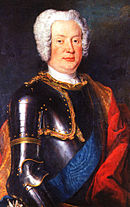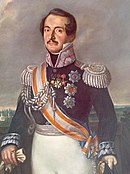Sułkowski
Sulkowski is a Polish noble family belonging to the Sulima coat of arms .
Origins
The origins of the family are unclear. The progenitor is said to have been a knight Sulima from the 12th century. In addition to the Sulkowskis, other sexes are said to descend from this. At the time of the Piast kings they are said to have had count-like rights. The certificate of elevation to the imperial count status from 1733 even claims a descent from the Solms family .
The family, which used to have a different name, has now named itself Sułkowo Borowe after the Sulkow estate . Only a few remains of the headquarters have survived. The first reliable representatives date from the 16th century.
One Pawel was married to Franciszka Maciejowska. His son Jan was married to Katarzyna Dluska. He had an unmarried son who served under Wallenstein and left a large fortune. The second son was a Sebastian who married Barbara Razyminska. Stanislaw was born around 1650 and became Płock's chamberlain . He was married to Ełzbieta Szalewska.
Princely family branch


The son Aleksander Józef Sułkowski (1695–1762) was a Polish-Saxon statesman and minister. Emperor Charles VI. awarded him the dignity of imperial count and the incolate of Bohemia and Silesia . King August III. gave him the rule of Ubigau near Wittenberg . He also acquired large estates in Greater Poland , including the Leszno County . Later in 1752 he bought the Bielsko dominion in Upper Silesia from Jan Sunneghin and the Rydzyna ( Reisen ) dominion from Stanisław Leszczyński . In 1752 he was raised to the hereditary imperial prince and the dominion of Bielitz to the principality. In 1754 these rights were extended to all descendants and he was given the right to acquire imperial fiefs. Alexander Josef was married twice. First marriage to Maria Anna Franziska von Stain zu Jettingen . In his second marriage he was married to Anna Przebendowska, daughter of the voivode of Marienburg.
The first son and main heir August Kazimierz Sułkowski (1729–1786) was, among other things, a Polish general and marshal of the Sejm. He had the reconstruction of the Rydzyna Castle completed. The Sejm has given him the Ordinat Rydzyna (a kind of privileged majority possession) because of his services to the state. He was married but had no offspring.
Alexander Antoni Sulkowski (1730–1796) was a Polish general and an imperial field marshal lieutenant. He followed his brother as Prince of Bielitz and in the Ordinate of Rydzyna. He was also the owner of the Kottingbrunn estate in Lower Austria . He did not leave any children either.
Bielsko line
Franciszek de Paula Sułkowski (1733-1812) was also a Polish and later a Russian general. He was the founder of the Bielsko line. He followed Alexander Antoni as Prince of Bielitz. Alexander Ludwig moved to Austria in 1944, and Bielitz Castle was expropriated in 1945.
Descendants of this line live in Austria, Germany, Hungary and North America.
Rydzyna line
Antoni Sułkowski (1734–1796) was a Polish general and chancellor. He was the founder of the Rydzyna line and holder of the ordinate. The son Antoni Paweł Sułkowski (1785-1836) was general of the Duchy of Warsaw . The grandson August Anton Sułkowski (1820–1882) and the great grandson Anton Sułkowski (1844–1909) were members of the Prussian manor house . The Rydzyna line died out in 1909.
Castle in Leszno
Non-princely branch
Stanislaw had other children in addition to Aleksander Józef Sułkowski. These and their descendants, if any, formed the non-princely family branch. Including the unmarried Saxon infantry general Michael Sulkowski († 1747), the Polish generals without descendants Kazimierz Sulkowski (1729–1805) and Ignacy Sulkowski († 1795) as well as the adjutant of Napoleon in Italy and Egypt Jozef Sułkowski (1723–1798).
Ranks
- Count status for Aleksander Józef Sułkowski by the Saxon Elector and Polish King August III. 1732 with improvement of the coat of arms.
- Incolation of the Bohemian gentry by Charles VI. with title Hoch- und Wohlgeboren from 1733. In the same year imperial count.
- The rulership of Bielitz was raised to the status of a principality and raised to the prince status by Maria Theresa as Queen of Bohemia in 1752.
- The princely lines received a special diploma from the Prussian king in 1819, which guaranteed them the title of Your Highness.
people

- Aleksander Józef Sułkowski (1695–1762), Duke of Bielitz and Saxon-Polish minister
- Antoni Paweł Sułkowski (1785–1836), Polish general
- August Kazimierz Sułkowski (1729–1786), Polish politician and general.
- Jozef Sułkowski (1773–1798), Polish and French officer
literature
- Genealogical-historical-statistical almanac for the year 1832 . Weimar 1832, pp. 162-163. .
- General German real encyclopedia for the educated classes . Volume 10, Leipzig 1837, pp. 848-849.
- Rudolph Baron Stillfried: Historical and genealogical news from the Sulkowski family. In: General archive for the history of the Prussian state. Berlin u. a., 1831 pp. 98-110
- Constantin von Wurzbach : Sulkowski, the princes, genealogy . In: Biographisches Lexikon des Kaiserthums Oesterreich . 40th part. Kaiserlich-Königliche Hof- und Staatsdruckerei, Vienna 1880, pp. 298–300 ( digitized version ).
Individual evidence
- ^ Siebmacher: Large and general book of arms. Vol. 14, Dept. 14. Nuremberg, 1906 p. 64



